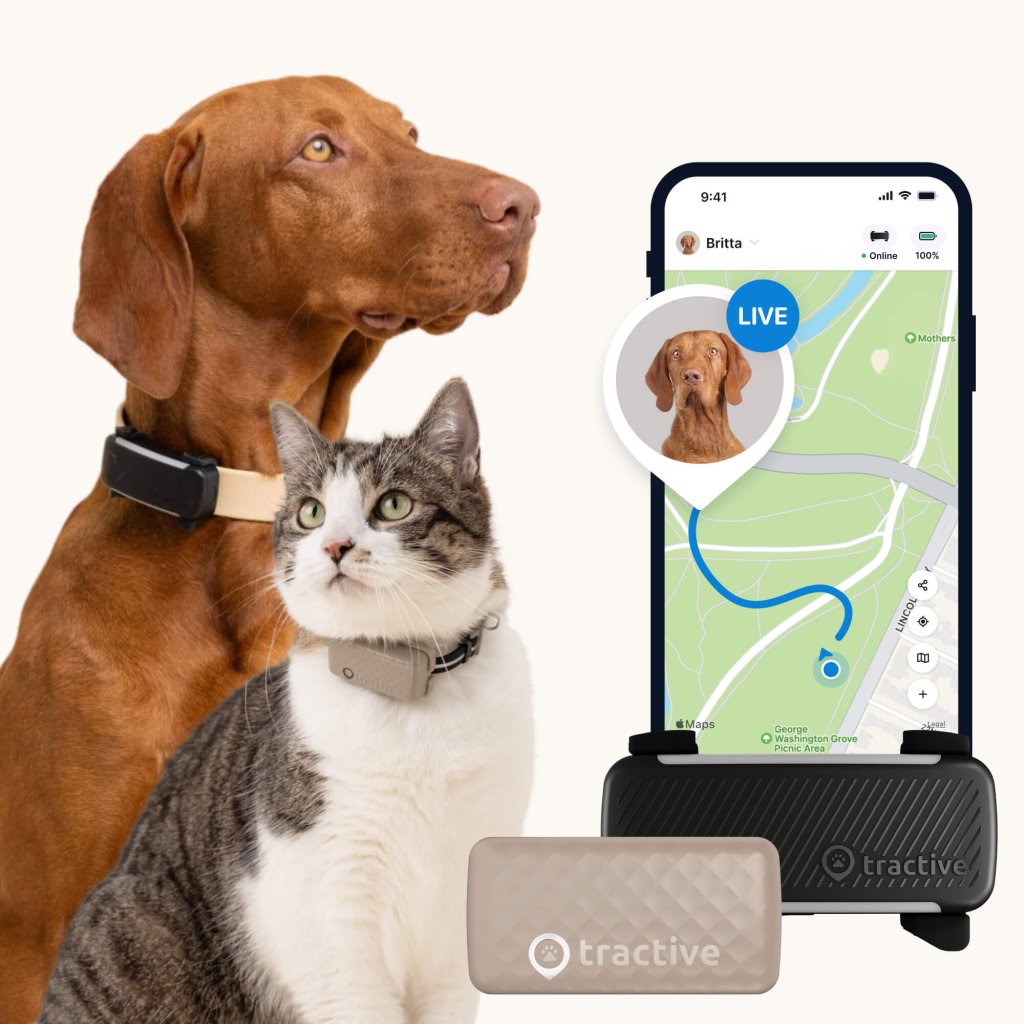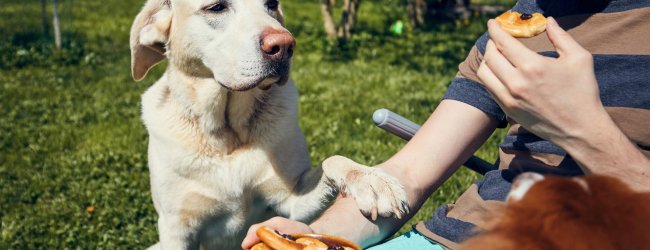Halloween Safety Tips for Dogs & Cats
Halloween can be a ton of fun for us - but it can be one big fright for your dog or cat. With these Halloween safety tips, you'll be on your way to a safe & spooky October.

Halloween can be a frighteningly fun festival for most of us. But for our pets, it might just be one big, nasty fright instead. So if you’re a dog or cat parent, you might find them tangled in your decorations, hiding away from any partygoers at home, paralyzed with fear – or bolting out of your door the minute you open it for some trick or treaters. But with these practical Halloween safety tips, you’ll be on your way towards a safe, spooky October holiday in no time.
Key Takeaways
On Halloween, it’s best to keep your pet’s routine as normal as possible to help them feel safe and calm.
Keep all your Halloween candy far away from your pets. (Especially chocolate.) These treats can be very dangerous for them to eat.
You can help your pet feel less stressed during the holiday by giving them a quiet place to hide from the noise of trick-or-treaters or parties and by making sure they get plenty of exercise before the evening begins.
If you’re worried about your pet getting scared and running off, you can use a Tractive GPS tracker to keep tabs on them in real-time. This way, if they happen to get loose, you can find them right away.

Always know your buddy is healthy & safe
Read more- Key Takeaways
- Halloween safety tips for your pets
- Pick pet-friendly Halloween decorations
- Avoid fitting Halloween costumes for your pets
- Keep your pets away from the Halloween candies
- Never leave your pets unsupervised during parties
- Let your pets know it’s you behind the costume.
- Watch the door when the trick or treaters come knocking
- Fix up your outdoor Halloween decor
- Get your pet some exercise before the Halloween party
- Be extra careful when walking your dog on Halloween night.
- Can I leave my dog or cat home alone for Halloween?
Halloween safety tips for your pets
Halloween can be a frightening night for our dear four-legged friends. It could be because of:
- Your new, creepy indoor decor
- The odd costumes
- The large number of strangers coming to the house
- Loud noise (like fireworks or music)
- All the festivities in general
Your pets might also find themselves in some precarious situations once you start spooking up your indoor decor, figuring out costumes and candy – and writing out your guest list. So here are a couple of Halloween safety tips for a pet-friendly October.
Pick pet-friendly Halloween decorations
Opt for LED lights inside your jack-o’-lanterns. Your pets might knock over candles, which might injure them – or even start a fire. That’s why it also makes sense to invest in sturdy Halloween decorations. Avoid fragile pieces your dog or cat might break (or swallow) by accident. Or if they do break, go for materials that won’t break into small pieces. Likewise, avoid decorations that dangle or have quick flashing lights. Slow gleaming fairy lights are fine, but anything faster might just stress out your pets.
You could also fasten your decorations to hard to reach places. This can prevent your cat from jumping towards them or scratching them. They might try to climb or play with these, which can lead to accidents or damage. Be extra careful of any electrical cords. Your pet might chew on these and end up getting shocked by accident. We’d recommend using cord protectors or just hiding them out of reach.
If all else fails, you could try and stick your decorations in place with clear tape. Just make sure your dog or cat doesn’t end up scratching the paint off your walls trying to get to them. We’d also recommend you take a few minutes to read the back of any decoration product labels. You want to make sure you’re not hanging up, say, fake cobwebs that might be toxic for your pets if they ingest it by mistake.
Avoid fitting Halloween costumes for your pets
Avoid costumes that have too many dangling pieces. (Like strings, buttons, ribbons, or other easily-scratchable bits.) Your cat, for example, might injure themselves trying to claw their way out of an uncomfortable costume. Or accidentally swallow a loose, dangling piece by accident. Likewise, avoid putting your pet into a costume you might have painted. Paints can be toxic for pets if they lick them by accident. Or they might end up with a skin allergy instead.
We’d also recommend you avoid costumes (like hats) which you’d need to strap on to your pet’s fur. It might just irritate them instead and lead them to claw and bat at it to get it off. Which might end up injuring them instead. Also avoid masks or shoes, which might stress out your pet from any mobility restrictions.
If you’ve found a comfortable costume (like a kid’s-sized top), start by introducing it to your pet first. If your dog whines or your cat hisses or bats at you when you’re trying to fit them into any costume, it might be better to let them attend this Halloween au naturel.
Good to know: Some costumes can easily obstruct your pet’s vision, breathing or movement. We’d recommend you avoid all such pieces of clothes. We’d also recommend never leaving your costumed pet unsupervised. You want to be able to intervene if they get a paw or their head stuck somewhere or generally seem in distress.
Keep your pets away from the Halloween candies
While it’s tempting to let your pets in on the Halloween fun, Halloween candies are generally a no-no. Candy is dangerous for dogs and cats, and chocolate can be fatal, since it contains Theobromine, which can cause nerve damage and even death. Most Halloween candies also contain ingredients like xylitol, which can be fatally toxic for your dog or cat. So don’t forget to throw away all candy wrappers before your four-legged friends get to them, since the wrappers can cause choking.
If you suspect your pet might have eaten something they shouldn’t have, watch out for:
- Diarrhea
- Vomit
- Irritability
- Increased heart rate
- Muscle tremors
Important: If your dog or cat has any of these symptoms, you can be sure that it wasn’t your children eating the chocolate. In this case, you should call a vet as soon as possible.
Never leave your pets unsupervised during parties
Even if it’s your friends and family, we’d always recommend knowing where your pet is during your Halloween celebrations. One of the first signs of a stressed out pet is one that’s disappeared. Both dogs and cats tend to hide for a number of reasons. And the primary ones are when they’re overwhelmed from being surrounded by so many different people, loud music, noise, and more.
So stay prepared for this – and ensure your pet has a safe hiding place where they can withdraw for a bit of cool-off time. Ideally, keep something around with your scent (like a scarf or a blanket you’ve slept in) so they feel more comfortable.
We’d also recommend you never force your pet to interact with others. (Both humans and other pets.) This too can overwhelm them – your cat might hiss, bite, or scratch at you in self defense. Rather, it’s wiser to give them some time to recharge their batteries and approach you when they’re ready. And in case you’re expecting some younger guests over this Halloween, remind them to be extra gentle with your pets.
Let your pets know it’s you behind the costume.
You’re wearing a costume and you dog or cat doesn’t seem to recognize you? Don’t be surprised! You might just freak them out when you suddenly change your form and figure. A helpful idea would be to allow your dog or cat to watch you put on your costume. This way, it’s easier for them to get used to the transformation. During the evening, you should take of your mask (or parts of the costume) to show your pet that it’s still you underneath the clothes.
Most importantly, avoid scaring your dog or cat with your Halloween costume. The resulting stress and anxiety it might put them through is never worth it.
Watch the door when the trick or treaters come knocking
“Trick or treat!” comes the chant – and while you’re busy handing out candy to your neighbors’ kids, your dog or cat might sneak outdoors without you noticing. And in the hustle and bustle of Halloween night, you’re more likely to miss out on when they’ve crept outdoors. Which comes with its dangers, from predators, pests, and people alike.
Besides sneaking out, your cat might feel anxious and stressed from the constant doorbell ringing and presence of strangers can cause your cat to feel anxious and restless. Or your dog might run to greet every newcomer – which might also end up in an escape attempt. (Or two.)
So if you’re expecting more foot traffic near your home this Halloween, consider keeping your pet in a secure, quiet room indoors to prevent them from escaping. Check up on them periodically to make sure they’re doing okay. If your dog or cat is in the habit of exploring the great outdoors, they might get bored or anxious from being confined indoors. So make sure they have an enriching indoor environment to keep them happy and busy. Else, as an emergency measure, a pet GPS tracker can help alert you to an escape – and track your pet’s every move in real-time.

Keep your pets healthy & safe
Get real-time location information, wherever they go. See how much – or how little – activity they’re getting. And get Health Alerts if something might be wrong.
Fix up your outdoor Halloween decor
Besides the inside, your outdoor Halloween decorations might need a bit of a once-over too. We’d recommend avoiding fake tombstones or animatronics in your yard, as they might frighten your pets or encourage them to flee. (Or pick a fight with them instead.) Rather, test them out with them before you set them up. If they spook your dog or cat, you’re better off investing in something that’s less likely to send them bolting off into the dangers outdoors.
Both dogs and cats can also safely eat pumpkins2 – which puts your outdoor decor under threat if you’ve set up a bunch of them in your garden. Plain pumpkin is safe for both, but consider serving these sparingly. (Since their digestive system is better designed for handling meat instead.)
However, be extra careful if you’ve placed fake pumpkins in your yard. If you’ve set up some that are made with toxic materials, your pet might get sick from taking a bite out of them instead.
Get your pet some exercise before the Halloween party
The first step in preparing your dog or cat for a relaxed Halloween evening is to exercise with them earlier that day. Get them some healthy movement by walking, running, hiking, or playing together. Because if your pet is tired by the end of the day, they’re more likely to chill out when the evening comes. (Yes, even your cat who’s naturally more active around twilight.) So when the trick-or-treaters come knocking, they’re less likely to be on alert.
Don’t forget: Many people dress up in costumes already in the morning. So be aware of strangers in costumers also when you walk your dog before the festivities begin. Keep a firm grip on your pet’s leash in case you meet people in costumes.
Be extra careful when walking your dog on Halloween night.
The spooky night is over, what now? Here a few final Halloween safety tips for safely walking your dog or cat in the dark. Specifically, watch out for candy leftovers and wrappers on sidewalks and streets. Make sure your pet doesn’t pick up any pieces they can choke on. We’d also recommend picking a route that’s a bit more wooded and surrounded by nature, free of Halloween leftovers.
Can I leave my dog or cat home alone for Halloween?
In general, we don’t recommended leaving your dog or cat home alone on Halloween. This is because the combination of loud noises, the doorbell ringing, and strangers dressed up in scary costumes walking around your home may be terrifying for your furry friend. If possible, get a friend or family member to take care of your dog or cat at home while you go out and enjoy the Halloween fun. Experts, for example, don’t recommend leaving your cat home alone for longer than 24 hours.
Ready for a safe spooky season this year? Keep those treats well out of reach, tire out your dog and cat with some playtime before the event, and consider skipping putting them in a costume. Happy trick or treating!



